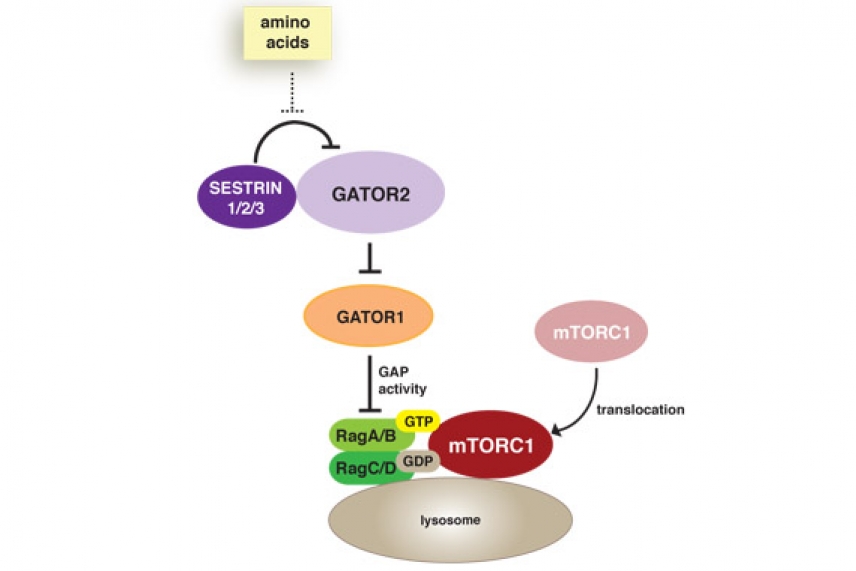
A model for the role of the Sestrins in the amino acid branch of mTORC1. The Sestrins are negative regulators that interact with GATOR2 in an amino acid sensitive fashion to control mTORC1 localization to the lysosome.
New protein players found in key disease-related metabolic pathway
CAMBRIDGE, Mass. – To coordinate their size and growth with current environmental conditions, cells rely on the mechanistic target of rapamycin complex 1 (mTORC1) pathway, which senses cellular stresses, growth factors, and the availability of nutrients, such as amino acids and glucose.
For years, Whitehead Institute Member David Sabatini and his lab have been teasing apart the numerous proteins involved in this vital metabolic pathway, in part because mTORC1 function is known to be deregulated in a variety of diseases, including diabetes, epilepsy, and cancer.
“We want to understand how our cells sense nutrients and how they transmit that signal to mTORC1,” says Lynne Chantranupong, a graduate student in Sabatini’s lab. “We started at the mTORC1 kinase and are building the pathway up piece by piece to identify who is talking to whom in the pathway and to understand how each of those proteins is relaying information about the availability of nutrients in the cell.”
Now Sabatini’s lab is adding to our understanding of the pathway by implicating a trio of poorly understood growth regulators called the Sestrins. Chantranupong and Rachel Wolfson, who is also a graduate student in Sabatini’s lab, describe their work with the Sestrins this week in an online edition of the journal Cell Reports.
Working in human cells, Chantranupong and Wolfson found that the Sestrins are major indirect negative regulators of mTORC1 signaling. Upstream of the mTORC1 complex are several protein complexes and kinases, including two related protein complexes, GATOR1 and GATOR2, and the Rag GTPases. In the absence of amino acids, the building blocks of proteins, the Sestrins work cooperatively to somehow inhibit mTORC1signalling by interacting with GATOR2.
“There’s still a lot we don’t know about the mTORC1 pathway,” says Wolfson. “The more proteins we find, the more complicated it becomes, which makes sense for a pathway that mammalian cells use to respond to a variety of nutrient conditions. The big hole we’re still working on is that we don’t know the mechanism through which the Sestrins affect the pathway.”
Determining the other proteins involved in the mTORC1 pathway remains a focus for Sabatini’s lab.
“As more members of the pathway are identified, there is an increased number of potential drugs targets,” says Sabatini, who is also a Howard Hughes Medical Institute investigator and a professor of biology at Massachusetts Institute of Technology. “This could ultimately allow for the development of a variety of drugs that can more specifically modulate the mTORC1 pathway. As for the Sestrins, without knowing their function, it’s difficult for us to say how easy they would be to target, but I think the more possibilities you have, the greater the potential is for finding viable drug targets.”
This work is supported by the National Institutes of Health (R01 CA103866, AI47389, F31 CA180271, T32 GM007753, T32 GM007753, Paul Gray UROP Fund (3143900), and GM67945) and Department of Defense (W81XWH-07-0448).
* * *
David Sabatini's primary affiliation is with Whitehead Institute for Biomedical Research, where his laboratory is located and all his research is conducted. He is also a Howard Hughes Medical Institute investigator and a professor of biology at Massachusetts Institute of Technology.
* * *
Full Citation:
Chantranupong, L., Wolfson, R., Orozco, J., Saxton, R., Scaria, S., Bar-Peled, L., . . . Sabatini, D. (2014). The Sestrins Interact with GATOR2 to Negatively Regulate the Amino-Acid-Sensing Pathway Upstream of mTORC1. Cell Reports, 9(1), 1-8. doi:10.1016/j.celrep.2014.09.014
Topics
Contact
Communications and Public Affairs
Phone: 617-452-4630
Email: newsroom@wi.mit.edu


